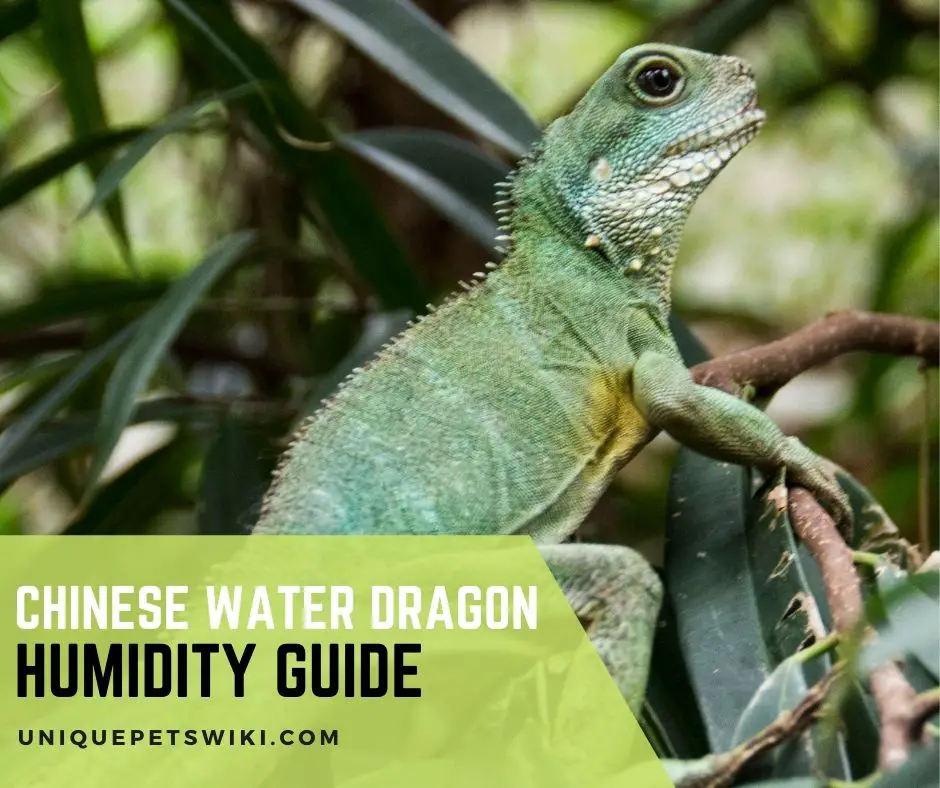These brilliant green lizards with big golden-brown eyes are native to China, Thailand, Vietnam, and Cambodia, and are known as Chinese or Asian water dragons or green water dragons.
They may be found in the wild in tropical rainforests, generally near a water supply.
Whether you are an interested lizard enthusiast or a long-time pet owner, Chinese water dragons have specificities when it comes to their needed care and maintenance.
This article contains a complete humidity guide and maintenance tips to share with you.
Contents
Chinese Water Dragon Humidity: How is Ideal?
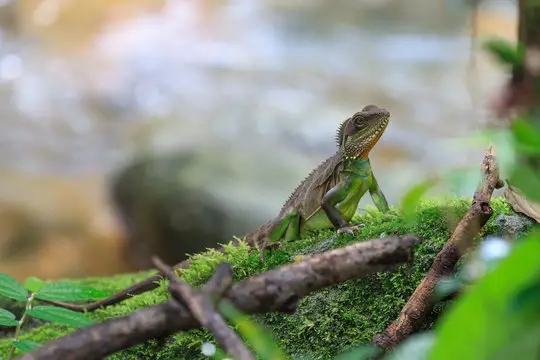
A humid environment is ideal for Chinese water dragons. It is recommended that humidity of around 80% is maintained inside your pet’s enclosure.
A screened enclosure will not be ideal for sustaining the required heat and humidity spectrum for your water dragon unless you reside in a warm, humid region.
Humidity may be increased by adding water to the cage, as well as living plants and a dirt substrate.
In the wild, they prefer freshwater streams, lakes, and rivers as a habitat.
They reside in thickly wooded settings near these water bodies, such as rainforests and swamps, and spend most of their time in the trees at the water’s edge.
Chinese water dragons prefer environments that are humid – typically with temperatures that range from 80 to 100 degrees Fahrenheit.
Importance Of Humidity For Chinese Water Dragon Growing
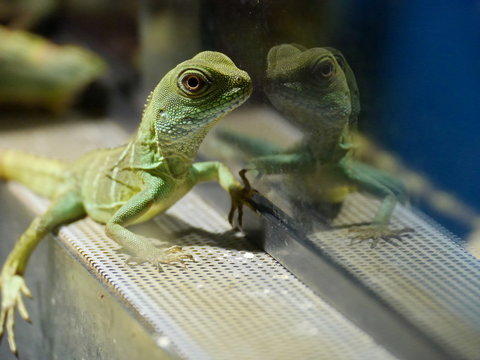
To keep comfortable in their confinement, they require a lot of water. Maintaining humidity levels in your Chinese water dragon’s cage is critical for shedding.
If there are any issues with natural skin shedding, your pet’s appearance may be unappealing. Excess skin may become adhered to your dragon’s toes or tail end, resulting in illness.
What Happens If Chinese Water Dragon Humidity Is Incorrect
Chinese water dragons kept in a cage with insufficient humidity will suffer from injury and result in a disaster.
Increased humidity can lead to respiratory illnesses, bacterial and fungal development on the skin and substrate, and other issues.
Their fragile skin does not retain water as effectively as other skin types. On the other hand, your pet Chinese water dragon may become dehydrated and die if the humidity is too low.
Using a hygrometer is the most convenient way to determine and maintain the temperature and humidity level inside the enclosure.
Chinese water dragons prefer a humid environment, thus ensuring that the humidity level in the enclosure remains consistently high, exceeding 70% at all times.
How To Maintain Humidity In Chinese Water Dragon Tank
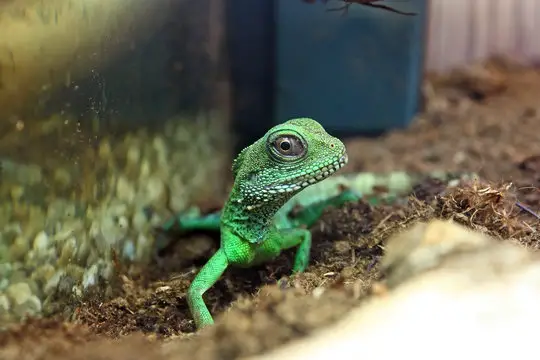
Maintain a humidity level of roughly 80%. If you happen to reside in an area with a wet climate, spraying the enclosure a few times a day will be enough. In this case, a good humidity gauge will come in handy.
Hand or automated misters such as the Exo Terra monsoon or Zoo med’s repti fogger are also good options for misting.
The Exo Terra reptile fountain emits bubbling water that helps to increase humidity levels.
Examples of products that are naturalistic non-porous water bowls include Exo Terra bowls, Fluker’s rock dish, and magnaturals enormous 5 gal bowl.
In the wild, Chinese water dragons are fond of swimming. If you acclimatize your pet while they are still newborns, you may bathe them in a bathtub or child pool.
Enclosed Cages or With Sliding Doors and Solid Lids
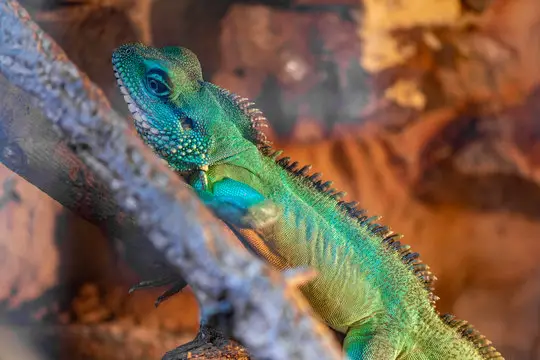
It might be difficult to keep the humidity in the cage at a constant level.
Enclosed cages, whether made of glass or wood, with sliding doors and strong lids, are frequently able to maintain adequate humidity levels.
Moisture will easily be decreased or lost if the enclosure of your Chinese water dragon is partially or entirely covered by a metal screen.
You’ll need a humidifier for your Chinese water dragon in a cage-like this. Even with a humidifier, maintaining consistent humidity levels may be difficult especially in areas with hot or dry weather.
In such instances, a cage built of the metal screen will only help to regulate humidity to a limited extent.
Cover one or a couple of mesh or metal screen sides in the enclosure with a cloth. Covering both sides isn’t a good idea because ventilation is crucial.
If the enclosure is solely covered by a metal screen lid, you can use a towel to partially cover it. However, do note that all sides should be blocked.
Also read: Chinese Water Dragon Enclosure: A Detailed Set-up Guide
Provide A Large Pan Deep Enough To Basking
Chinese water dragons require high humidity levels and like soaking and swimming. As a result, you’ll need a pond or a tub big enough for your pet.
To do so, you can add a huge plastic/bus tub into which you will fill the water. You may also make a paludarium or a separate pond.
You may need to use plexiglass or something similar to divide an area and install double to triple filtration.
Because the water in the swimming area must be filtered, you will only need to replace the water once every 2-4 days rather than daily but keep it clean.
A basic or a waterfall-like filter can be used to clean the water.
Chinese water dragons generate a lot of wastes and will surely defecate in the water. Thus, you have to add one or two filters to keep the water clean for at least two to three days.
However, you must replace the water every day if you do not use a filter.
Additionally, you must check if the water is flowing in the enclosure.
The movement of water attracts green water dragons so if your pet chooses to swim during the day, this is where it will acquire its moisture from.
If the water in the pool is not warm enough, you may use a submersible water heater to slightly increase its temperature.
It is critical to heat the water for soaking since your Chinese water dragon’s muscles will weaken in cold water. This may result in drowning.
For Chinese water dragons, the ideal water temperature is between 80 and 85 degrees Fahrenheit (26-29 degrees Celsius).
PINVNBY Resin Reptile Platform Artificial Tree Trunk Reptile Tank Decor Food Water Dish Bowl
- Made of premium resin and Eco-friendly material, non-toxic, pollution-free, completely safe for aquatic life.
- Lifelike rock desing, provide a natural environment for your reptiles.decorate and maintenance your aquarium
- Designed with flat bottom, stand in your water tank or aquarium easily and steadily.
- Well design with shallow bottom, making it easier for your pet to eat.
- Size of 7.1 x 6.3 x 3.9 inch Suitable for small size reptiles, like bearded dragon,tortoise, lizard,snake, frog, gecko or other reptiles.
Last update on 2022-12-29 / Affiliate links / Images from Amazon Product Advertising API
Create An Waterfall or Misting The Cage
Because the humidity level must be sufficient, a water dish at the bottom of the tank will not suffice.
You may, for example, acquire an ultrasonic misting system to make your life simpler. You may construct a program and specify timings for misting the tank automatically with a misting system.
The technology will then spray a thin mist into the tank, which is handy.
You may also use a fogger instead of a misting system. This fogger will also produce a cool fog in the tank of your Chinese water dragon, instantly increasing humidity levels.
The fogger may then be connected to a timer and turned on and off at predetermined intervals.
If your Chinese water dragon’s tank lacks a fogger or mister, you can manually spray your dragon and tank 1-3 times each day.
The number of times you need to spray depends on the time of year and the size of the cage.
Instead of pouring excessive water on your pet or substrate, you may use a mister for added moisture to provide enough airflow and also aid in maintaining the humidity. Remember to use warm water.
Naturalistic Terrarium Waterfall Kit
- Incorporate a beautiful waterfall feature in your naturalistic terrarium.
- Kit includes: water pump, hydro balls, terrarium mesh, Plastic Tubing and Plastic elbow.
- All-inclusive terrarium waterfall kit has everything you need to maintain humidity levels in your reptile's environment
Last update on 2022-12-29 / Affiliate links / Images from Amazon Product Advertising API
Using Substrate To Maintain Cage Humidity
At the bottom of the tank, a humidity-retaining substrate/bedding will assist retain moisture and keep the tank damp.
Large orchid chips, sterilized dirt, or coconut coir with some bark are the finest bedding alternatives for a Chinese water dragon’s home. A nice choice is cypress mulch covered with big orchid bark.
Bark will assist to keep moisture in the tank, but it won’t get too wet and clumpy, adhering to your dragon and other tank decorations.
Add Live Plants
To promote and support a humid environment for your pet, you may place live plants inside the enclosure. Ensure that the plants are non-toxic and capable of withstanding your pet.
The good options for live plants that you can try using or placing inside the enclosure are Dracaena, hibiscus, ficus shrubs, Pothos, Philodendron, and spider plants.
How To Decrease Humidity Level And Preventing Mold
The quickest approach to reduce humidity is to open the windows. Closed terrariums must be ventilated regularly. Stop misting open terrariums.
The humidity will be reduced if there is less water in the cage. Removing larger plants from terrariums reduces humidity immediately.
Increasing Ventilation
Removing the cover from a closed terrarium to air it out is the most effective and quickest technique to reduce humidity.
This should be done every month. The terrarium’s size determines how much air it needs.
Enclosures made of glass bottle material should be ventilated once a month for 20 to 30 minutes. Larger enclosures may require the cover to be removed for a few hours once a month.
REPTI ZOO 50 Gallon Reptile Glass Tank
- [Patent Design] IMPORTANT NOTICE: All glasses are upgraded to tempered glasses. DO NOT cut or punch any holes on the glass, otherwise it will be damaged.
- 2 in 1 Side Meshes and Side Glasses Switched Easily: Great for different needs, the side meshes and side glasses can be switched according to the environment, provide your reptile or amphibian with a durable and comfortable environment to live in.
- Raised bottom frame in order to fit a substrate heater; Waterproof bottom makes this tank can be used both as desert terrarium and rainforest tank.
- Front doors can open separately, easy to feed your pet and prevent escape.
- Window ventilation on left and right, on top and right have closable inlets for wires and tubing.
Last update on 2022-12-29 / Affiliate links / Images from Amazon Product Advertising API
Reduce Water Availability In Cage And Stop Misting
Watering damp surfaces is not a good idea as it might cause rot or fungus growth. Therefore, keeping a water dish in the enclosure must be done.
If the humidity rises quickly inside the tank, there is more likely that a greater volume of water remains in the bowl and the temperature increases.
To keep the enclosure moist without soaking the substrate, you may use a water bowl. It only reduces humidity if you use this strategy to maintain humidity instead of misting regularly.
Allow Your Substrate To Dry Before Moistening Again
Wet substrates are often the cause of high humidity because the amount of water in the substrate evaporates.
Therefore, to reduce moisture, priority should be given to drying the substrate to avoid high humidity.
After the humidity is reduced, start misting the substrate again.
Different substrates are used in different terrariums. Some are more water-resistant than others and these are the kinds that you must be eyeing to use in the enclosure.
Because moss requires high humidity, a typical potting soil is perfect for growing it in a terrarium.
The base of a succulent-filled terrarium, on the other hand, is coated with sand or gravel to keep the moisture in. The greater the humidity levels increase, the more water is stored by the substrates.
Using Springtails
Springtails are basically the cleanup crews for the enclosure. They also consume pollen, algae, feces, and bacteria. They are excellent for cleaning the enclosure and reducing the risk of mold.
Due to their inherent capacity to self-regulate their population, springtails thrive in reptile terrariums.
Springtails are best kept in a closed terrarium as part of a bio-active environment, but they may also be kept in an open terrarium if there is adequate moisture for them to stay.
Springtails are wonderful for keeping any reptile, even amphibian or plant, tank clean since they consume mold and fungus in the terrarium.
They also reproduce swiftly and effortlessly on their own, with little help from you.
Conclusion
Chinese water dragons prefer a humid environment. Therefore, it is important that you keep the humidity in the enclosure near 80%.
However, using a screened enclosure may not be the best option to do so, especially if you reside in a warm, dry region. Hope you found this material useful!
